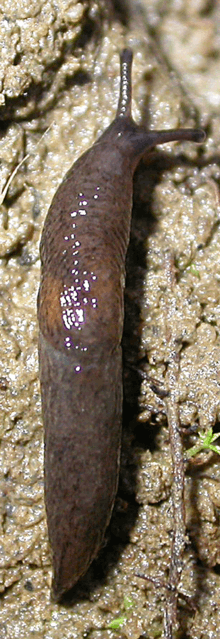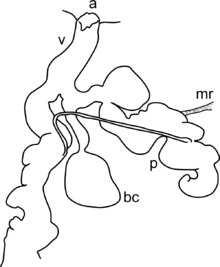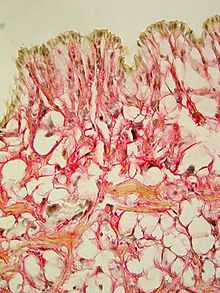Deroceras laeve
| Deroceras laeve | |
|---|---|
 | |
| Deroceras laeve | |
| Conservation status | |
| NE[1] | |
| Scientific classification | |
| Kingdom: | Animalia |
| Phylum: | Mollusca |
| Class: | Gastropoda |
| (unranked): | clade Heterobranchia
clade Euthyneura |
| Superfamily: | Limacoidea |
| Family: | Agriolimacidae |
| Genus: | Deroceras |
| Species: | D. laeve |
| Binomial name | |
| Deroceras laeve (O. F. Müller, 1774)[2] | |
| Synonyms[3] | |
| |
Deroceras laeve, the marsh slug, is a species of small air-breathing land slug, a terrestrial pulmonate gastropod mollusk in the family Agriolimacidae.
Distribution
The distribution of Deroceras laeve was originally Palearctic, from the subpolar zones to the southern margins.[4] Today this slug species has been introduced worldwide except Antarctica, also on tropical islands such as New Guinea and on Pacific islands.[4]
Europe:
- British Isles: Great Britain and Ireland. The species has shown little evidence for significant decline in Britain.[4]
- Czech Republic[5] - least concern (LC)[6]
- Netherlands[7]
- Poland
- Slovakia[5]
- Ukraine[8]
- Sweden
- Switzerland - lower concern in Switzerland[4]
- and others
Asia:
The Americas:
- California[12]
- El Hatillo Municipality, Miranda, Venezuela
- Colombia[13]
- introduced to Dominica (first report in 2009)[14]
- and others
Description
The slug is from brown to dark brown, usually with dark and characteristic but not well visible spots arranged in groups.[4] The shape is almost cylindrical, posterior end is abruptly widened.[4] The mantle covers 50% of body length (unusually large).[4] There are wrinkles on skin present (may disappear in preserved slugs).[4] Mucus is thin, colourless.[4]
This slug is 15–25 mm long when preserved.[4]
The populations of this species that occur in Central Europe are much darker than other Deroceras species in that area.

a - atrium
v - vagina
p - penis
mr - musculus retractor penis
bc - bursa copulatrix.
Reproductive system: Penis is often reduced, elongated if present, without proper penial gland but with two or more tiny glandular papillae and its end.[4] Retractor is unforked and attached at half penis length, stimulator small, cone-shaped but looks more like a papilla.[4] Tubular oviductus and atrium are unusually long.[4] There is no rectal caecum.[4]

Ecology
Habitat
Deroceras laeve has high ecological tolerance, but needs permanently wet habitats.[4] It is usually found in lowlands and very humid habitats, swamps, riversides, wetlands, especially alder and oak woods, marshlands and degraded areas, also greenhouses, often near water under wood or detritus.[4] It tolerates subpolar and tropical temperatures.[4] Newly created habitats are often colonized after a few years.[4] In Switzerland in up to 1800 m altitude, but usually below 1000 m, in Bulgaria in up to 2500 m.[4]
Deroceras laeve can be a serious pest in greenhouses.[4] On the other hand the species is threatened by continuous elimination of wet habitats by drainage, construction projects and road construction.[4]
It is the only land gastropod that goes deliberately into the water and can survive for days submerged.[4] Because of this unusual behavior, the species can be dispersed by flowing water.[4]
Feeding habits
These slugs are agile and crawl quickly. They are omnivorous, but live and dead plant remains are preferred.[4]
Life cycle
The eggs of this species can also survive when submerged; juveniles can hatch underwater and then climb to the surface.[4]
The life cycle is extremely short, and can take place within less than a month.[4] This species can have up to 5 generations in a year,[4] with several generations alive at the same time.[4] Frequently there are forms with a reduced penis, which reproduce by self-fertilisation.[4] The maximum age of this slug is not more than 1 year.[4]
Parasites
Parasites of Deroceras laeve include:
References
This article incorporates public domain text from the reference [4]
- ↑ (2006). IUCN Red List of Threatened Species. <www.iucnredlist.org>. Cited 2 March 2007.
- ↑ Müller O. F. (1774). Vermivm terrestrium et fluviatilium, seu animalium infusoriorum, helminthicorum, et testaceorum, non marinorum, succincta historia. Volumen alterum. pp. I-XXXVI [= 1-36], 1-214, [1-10]. Havniæ & Lipsiæ. (Heineck & Faber).
- ↑ "Synonyms of Limax laevis (n=17)". AnimalBase, accessed 4 January 2011.
- ↑ 4.0 4.1 4.2 4.3 4.4 4.5 4.6 4.7 4.8 4.9 4.10 4.11 4.12 4.13 4.14 4.15 4.16 4.17 4.18 4.19 4.20 4.21 4.22 4.23 4.24 4.25 4.26 4.27 4.28 4.29 4.30 Species summary for Deroceras laeve. AnimalBase, accessed 4 January 2011.
- ↑ 5.0 5.1 (Czech) Horsák M., Juřičková L., Beran L., Čejka T. & Dvořák L. (2010). "Komentovaný seznam měkkýšů zjištěných ve volné přírodě České a Slovenské republiky. [Annotated list of mollusc species recorded outdoors in the Czech and Slovak Republics]". Malacologica Bohemoslovaca, Suppl. 1: 1-37. PDF.
- ↑ Juřičková L, Horsák M, Beran L (2001). "Check-list of the molluscs (Mollusca) of the Czech Republic". Acta Soc. Zool. Bohem. 65: 25–40.
- ↑ http://www.anemoon.org/anm/voorlopige-kaarten/landmollusken/wetenschappelijk/deroceras-laeve/
- ↑ Balashov, I.; Gural-Sverlova, N. (2012). "An annotated checklist of the terrestrial molluscs of Ukraine". Journal of Conchology 41 (1): 91–109.
- ↑ Hlaváč, J. Č. (2004). "A new record of Deroceras laeve (O. F. Müller, 1774) from Pakistan (Gastropoda: Pulmonata: Agriolimacidae)". Folia Malacologica 12: 181–182.
- ↑ Wiktor, A.; De-niu, C.; Wu, M. (2000). "Stylommatophoran slugs of China (Gastropoda: Pulmonata) – prodromus". Folia Malacologica 8 (1): 3–35.
- ↑ Tsai C.-L. & Wu S.-K. (2008). "A New Meghimatium Slug (Pulmonata: Philomycidae) from Taiwan". Zoological Studies 47(6): 759-766. PDF.
- ↑ Rory J. Mc Donnel, Timothy D. Paine & Michael J. Gormally (2009). Slugs: A Guide to the Invasive and Native Fauna of California. ISBN 978-1-60107-564-2.
- ↑ Hausdorf B (May 2002). "Introduced land snails and slugs in Colombia". J. Molluscan Stud. 68 (2): 127–131. doi:10.1093/mollus/68.2.127. PMID 12011238.
- ↑ Robinson D. G., Hovestadt A., Fields A. & Breure A. S. H. (July 2009). "The land Mollusca of Dominica (Lesser Antilles), with notes on some enigmatic or rare species". Zoologische Mededelingen 83 http://www.zoologischemededelingen.nl/83/nr03/a13
- ↑ Michigan Department of Natural Resources and Environment. "Brainworm". accessed 14 December 2010.
- Spencer, H.G., Marshall, B.A. & Willan, R.C. (2009). Checklist of New Zealand living Mollusca. Pp 196-219 in Gordon, D.P. (ed.) New Zealand inventory of biodiversity. Volume one. Kingdom Animalia: Radiata, Lophotrochozoa, Deuterostomia. Canterbury University Press, Christchurch
External links
| Wikimedia Commons has media related to Deroceras laeve. |
- Deroceras laeve at Animalbase taxonomy,short description, distribution, biology,status (threats), images
- Deroceras laeve images at Encyclopedia of Life
- Fauna Europaea Search Distribution
- Deroceras laeve on the UF / IFAS Featured Creatures Web site